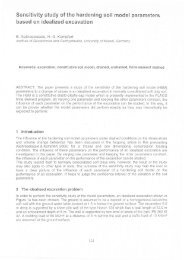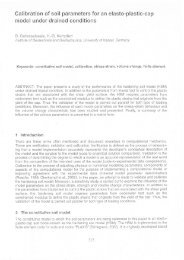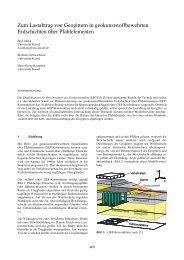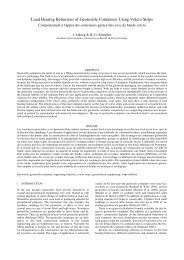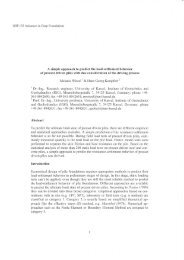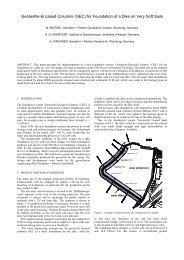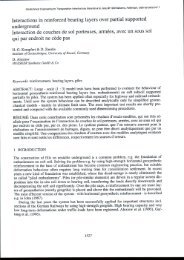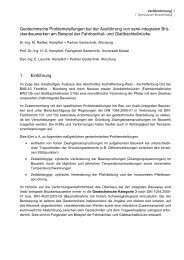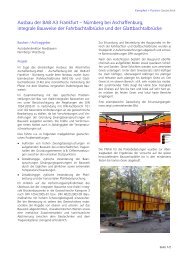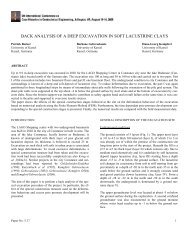Experience with friction-micropiled-raft foundation on soft soils
Experience with friction-micropiled-raft foundation on soft soils
Experience with friction-micropiled-raft foundation on soft soils
Create successful ePaper yourself
Turn your PDF publications into a flip-book with our unique Google optimized e-Paper software.
Proc. XIII ECSMGE, Vaniöek et ul. (eltr. O CG\S, Ptueue, ISBN 8t)-i36769-01-l (yal. 2)<br />
<str<strong>on</strong>g>Experience</str<strong>on</strong>g> <str<strong>on</strong>g>with</str<strong>on</strong>g> <str<strong>on</strong>g>fricti<strong>on</strong></str<strong>on</strong>g>-<str<strong>on</strong>g>micropiled</str<strong>on</strong>g>-<str<strong>on</strong>g>raft</str<strong>on</strong>g> <str<strong>on</strong>g>foundati<strong>on</strong></str<strong>on</strong>g> <strong>on</strong> <strong>soft</strong> <strong>soils</strong><br />
Une expdrience avec Ia micropieux-base de frottement dans les<br />
H.-G- Kempfen & F. Böhm,<br />
Lniversirl ofKassel, iwtitute ofGeotechnics, Kasse!, Cernßn!-; geo,eth@uni-kossel.de<br />
sols mous<br />
KEYWORDS: <str<strong>on</strong>g>fricti<strong>on</strong></str<strong>on</strong>g>-micropilcd-<str<strong>on</strong>g>raft</str<strong>on</strong>g> <str<strong>on</strong>g>foundati<strong>on</strong></str<strong>on</strong>g>, maintained load grouted pile test, setllement, <strong>soft</strong><br />
soil<br />
ABSTRACT: A new foundatioo system for buildings <strong>on</strong> <strong>soft</strong> <strong>soils</strong> using micropiles is reported irr this<br />
paper. The preseDted frictioo-micrupiled-<str<strong>on</strong>g>raft</str<strong>on</strong>g> <str<strong>on</strong>g>foundati<strong>on</strong></str<strong>on</strong>g> has successtitlly been realised for new buildings<br />
<strong>on</strong> <strong>soft</strong> <strong>soils</strong> to stabilise the underground and redrLce the settlement. An exemplcry comparis<strong>on</strong> of<br />
practical projects in terms of measured settlements of a rafi loundati<strong>on</strong> <str<strong>on</strong>g>with</str<strong>on</strong>g> the <str<strong>on</strong>g>fricti<strong>on</strong></str<strong>on</strong>g>-<str<strong>on</strong>g>micropiled</str<strong>on</strong>g><str<strong>on</strong>g>raft</str<strong>on</strong>g><br />
<str<strong>on</strong>g>foundati<strong>on</strong></str<strong>on</strong>g> <strong>on</strong> noamal c<strong>on</strong>solidatcd <strong>soft</strong> <strong>soils</strong> has proven the eff'ectiveness of the new <str<strong>on</strong>g>foundati<strong>on</strong></str<strong>on</strong>g><br />
system.<br />
RESUME: Le papier prdsente une soluti<strong>on</strong> pour c<strong>on</strong>struite les t_<strong>on</strong>dlti<strong>on</strong>s des bätiments sur les sols<br />
mous avec micropierx- La tbndati<strong>on</strong> avec lcs micropieur llottants a dte c<strong>on</strong>struit avec succCs dans<br />
nouveaux bätiments sur les sols mous pour stabiliser le sous-sol et pour r€duire le tassemeot.<br />
L'efficacitd du nouveau systöme est c<strong>on</strong>fiün€e au moyen de la comparais<strong>on</strong> des tassements des radiers<br />
de f<strong>on</strong>dati<strong>on</strong> avec les tassemenls des foüdati<strong>on</strong>s avec micropieux dans plusieurs c<strong>on</strong>structi<strong>on</strong>s sur les<br />
sols mous normal c<strong>on</strong>solid€es.<br />
I INTRODUCTION<br />
Several c<strong>on</strong>structi<strong>on</strong> measures have been realised in the southem Germrny <str<strong>on</strong>g>with</str<strong>on</strong>g> a piled-<str<strong>on</strong>g>raft</str<strong>on</strong>g> <str<strong>on</strong>g>foundati<strong>on</strong></str<strong>on</strong>g><br />
\rith micropiles <strong>on</strong> <strong>soft</strong> <strong>soils</strong>. Beside the stabilisari<strong>on</strong> elfecr ofrhe new <str<strong>on</strong>g>foundati<strong>on</strong></str<strong>on</strong>g> system, a sie<br />
nificant settlement reducli<strong>on</strong> against rali fouodati<strong>on</strong>s could be obscwcd. Kenpferr (1986) rcp<strong>on</strong>ed<br />
about the tirst positive experiences ofsuccessfully strcngthening an old raihay bridges abutment <str<strong>on</strong>g>with</str<strong>on</strong>g><br />
the illusüated <str<strong>on</strong>g>foundati<strong>on</strong></str<strong>on</strong>g> system.<br />
ln particular in urban areas, sefilements due to very thick layers of <strong>soft</strong> <strong>soils</strong> c:rn negative]y influence<br />
the neiuhbouring buildings <str<strong>on</strong>g>with</str<strong>on</strong>g> shallow tbundati<strong>on</strong>s, for example additi<strong>on</strong>al settlements due to<br />
nexly built sfucfures. Such seftiements can lie <str<strong>on</strong>g>with</str<strong>on</strong>g>in the iange of decimetres. The new <str<strong>on</strong>g>foundati<strong>on</strong></str<strong>on</strong>g><br />
system preseotcd in this paper enablcs to limil settlements to an admissible size, hence limiting possible<br />
negalive intluences <strong>on</strong> neighbouring buildings.<br />
A research project financed by the central public funding organisati<strong>on</strong> for academic research in<br />
Gemany (DFC) is utrder way at the lnstitute of Geotechnics, University of Kassel, covering all aspects<br />
ofthe beadlg caprcity ofinjecti<strong>on</strong> micropiles <strong>on</strong> <strong>soft</strong> normally coosolidated <strong>soils</strong>. ln the present<br />
paper the effectiveoess of the <str<strong>on</strong>g>fricti<strong>on</strong></str<strong>on</strong>g>-piled-rafi <str<strong>on</strong>g>foundati<strong>on</strong></str<strong>on</strong>g>s <str<strong>on</strong>g>with</str<strong>on</strong>g> grouted micropiles is iilustrated<br />
based <strong>on</strong> case studies ofpracrical projects-<br />
Micropiles were originally designed by the ttalian Zi:i to support and safegua.d <str<strong>on</strong>g>foundati<strong>on</strong></str<strong>on</strong>g>s at risk<br />
and patenled in 1952. Since theq micropiles have been used world-wide tb. distinct building measures.<br />
Bruce et a!. (1997) and Armour et al. (20001 summarised a rcpofi ofworld wide realiscd projects sDch<br />
as <str<strong>on</strong>g>foundati<strong>on</strong></str<strong>on</strong>g> underpinning, slopc stabilisrti<strong>on</strong>, slope r€inforcement and gravity retaining strrctures.<br />
At present therc are just few re,llised tricti<strong>on</strong>-piled-ral't <str<strong>on</strong>g>foundati<strong>on</strong></str<strong>on</strong>g> <strong>on</strong> <strong>soft</strong> soil reported in literature-<br />
.\loin Sessi<strong>on</strong> 1 'Foundan<strong>on</strong>s in urban ureas'<br />
::9
'proc. XLLI ECSMGE, l/aniöek et al. (eds). @ CGß, Prague, ISBN 8G86769-01-l (yot. 2)<br />
Exampies of buiiding <str<strong>on</strong>g>foundati<strong>on</strong></str<strong>on</strong>g>s <str<strong>on</strong>g>with</str<strong>on</strong>g> micropiles found in literature are mainly deep <str<strong>on</strong>g>foundati<strong>on</strong></str<strong>on</strong>g>s,<br />
where the pile toe penetrates the underlying bearing layer. An overview of<str<strong>on</strong>g>foundati<strong>on</strong></str<strong>on</strong>g>s <strong>on</strong> <strong>soft</strong> <strong>soils</strong> in<br />
Mexico city is given by Auviaet {2002). He investigated the reacti<strong>on</strong> ofthe <str<strong>on</strong>g>foundati<strong>on</strong></str<strong>on</strong>g> system to seismic<br />
excitati<strong>on</strong> in additio[ to the static loads.<br />
Over the years, different types and manufacturing methods ofmicropiles werc invenred. The piles<br />
discussed hereafter are ofthe GEwl type, DY-WIDAG System (see D.t1f2002))<br />
2 FOTINDATION SYSTEM AND SIJBSOIL<br />
Two <str<strong>on</strong>g>foundati<strong>on</strong></str<strong>on</strong>g>s of neighbouing buildings <str<strong>on</strong>g>with</str<strong>on</strong>g>ia the same locati<strong>on</strong> are compared hereafter- One of<br />
them, located south west (Fr'gure 1), c<strong>on</strong>sists of seven independent buildings <str<strong>on</strong>g>with</str<strong>on</strong>g> up to 4 storeys. The<br />
overall oute. size of the building is 100 x 42 m and it is founded <strong>on</strong> <str<strong>on</strong>g>raft</str<strong>on</strong>g> <str<strong>on</strong>g>foundati<strong>on</strong></str<strong>on</strong>g>. A new 4-storey<br />
building <str<strong>on</strong>g>with</str<strong>on</strong>g> mainly two pais alld a size of 15 x 43 m is located east ofthe described building- It is<br />
fomded <strong>on</strong> a fticti<strong>on</strong>-<str<strong>on</strong>g>micropiled</str<strong>on</strong>g>-<str<strong>on</strong>g>raft</str<strong>on</strong>g> <str<strong>on</strong>g>foundati<strong>on</strong></str<strong>on</strong>g> <str<strong>on</strong>g>with</str<strong>on</strong>g> 95 injecti<strong>on</strong> type piles.<br />
o4<br />
Fi$re 1, Siie map<br />
(:l<br />
(-_)<br />
/t)<br />
(:)<br />
(._]<br />
F;r. B r<br />
Tkr.cti<br />
The micropiles <str<strong>on</strong>g>with</str<strong>on</strong>g> a length of 16.25 m (GEWI-pile, DYWIDAG System) each and a diameters of<br />
150 mm were installed in a drilled hole <str<strong>on</strong>g>with</str<strong>on</strong>g> casing in a grid of2 to 3 m. Then the piles were grouted<br />
under prcssue of 25 to 30 bar at a depth of9 m and 14 m below the ground surface- A sec<strong>on</strong>d pressurc<br />
grouting was carried out <strong>on</strong>ce more <str<strong>on</strong>g>with</str<strong>on</strong>g> prcssures of 27-5 to 38.5 bar. F;gure 2 shows a typical cross<br />
secti<strong>on</strong>s ofthe investigated buildings and <str<strong>on</strong>g>foundati<strong>on</strong></str<strong>on</strong>g>s.<br />
230<br />
Sessi<strong>on</strong> 1 'Foundali<strong>on</strong>s in arban area|"<br />
^,Iain
Proc. XII LCS^,(GE, I/a\iöek et at. (edg. A CGIS, Prasrc, LSBN 8A-86769-AI I (ot. 2)<br />
;""i il.s' .l<br />
Figure 2. Cross secti<strong>on</strong> and subsoil profile (secti<strong>on</strong> A-A)<br />
.l<br />
1t<br />
iI<br />
fi di<strong>on</strong>-micropaled-<str<strong>on</strong>g>raft</str<strong>on</strong>g> fo<strong>on</strong>dali<strong>on</strong><br />
The ground c<strong>on</strong>diti<strong>on</strong> encountered in the southem Germany arcund lake C<strong>on</strong>stance c<strong>on</strong>sists ofnormal<br />
cotsolidated <strong>soft</strong> <strong>soils</strong> which extends up to a depth of60 m- The site investigati<strong>on</strong> at the sire (Figure 2)<br />
revealed a 2 - 3 m made ground overlying a very young normally c<strong>on</strong>solidated <strong>soft</strong> soil layer, c<strong>on</strong>sisting<br />
of clayey silts <str<strong>on</strong>g>with</str<strong>on</strong>g> pulpy to <strong>soft</strong> c<strong>on</strong>sistency and sorne organic comp<strong>on</strong>eots. This soil material is<br />
described hereefier as upper lacustrine clay. At a depth of 12 to 15 m below sulface, a transiti<strong>on</strong> layer<br />
ftom upper lacustrine clay to a lower lacustrine clay can be observed whjch c<strong>on</strong>sists ol <strong>soft</strong> to stiff<br />
clayey silts <str<strong>on</strong>g>with</str<strong>on</strong>g> inclusi<strong>on</strong>s ofthin horiz<strong>on</strong>tal flne sand bands. Beneath the lower lacustrine clay layer<br />
a moraine layer c<strong>on</strong>sisting ofclayey silts <str<strong>on</strong>g>with</str<strong>on</strong>g> large comp<strong>on</strong>ents ofsand aüd boulder was encountered<br />
at a depth of24 to 36 m.<br />
10<br />
_ l5<br />
E<br />
30<br />
35<br />
40<br />
wl%1<br />
20 4A 80<br />
"d-<br />
ax-v<br />
d"{<br />
+-s<br />
€<br />
.!o;<br />
c!lkN/m1<br />
40 80 124 O<br />
qcll\4N/m1 N.ll<br />
5 10 15 20 25A 2 4 6<br />
Figure 3- Compilati<strong>on</strong> ofwater c<strong>on</strong>tents, vane shear tests. penetrati<strong>on</strong> tests and heavy penetrati<strong>on</strong> tests<br />
A water o<strong>on</strong>tents around 30 %, and partly up to 90 o/o was measuled both in the uppe.lacusAine ciay<br />
and lower lacustrine clay (Figure 3). The same hgute shows a diagram oftwo tield vane test, a typical<br />
Mai Sessian 4 'Foundatialß inurban areas ' 231
Proc. XII ECSMGE, ,anlöek et al. (edt. A ÖGtS, Pra|ue, ISBN 80-86769-0t-j lrot. tt<br />
c<strong>on</strong>e pcnetrati<strong>on</strong> and heavy pcnetrati<strong>on</strong> tes! lesults. The average number ofblous in ihe upper lacustrine<br />
clay was Nro = 5and the maximum measured was Nro = 9.<br />
3 SETTLEIVIENI<br />
Settlement gauges were installed at different locati<strong>on</strong> ofthe buildings, in *.hich senlements of the <str<strong>on</strong>g>raft</str<strong>on</strong>g><br />
fbundati<strong>on</strong>s rvere evaluated from the inclinati<strong>on</strong> mersurement ofthe individual buildings, The c<strong>on</strong>tact<br />
pressure lies between 50 to 70 kN/mr. A back analysis result sho*s a seulement values berween 40 to<br />
180 mm. Figure 4a shows settlements ofthe individual buildings <str<strong>on</strong>g>with</str<strong>on</strong>g> <str<strong>on</strong>g>raft</str<strong>on</strong>g> foundäti<strong>on</strong>-<br />
The c<strong>on</strong>tact pressure utrder the <str<strong>on</strong>g>fricti<strong>on</strong></str<strong>on</strong>g>-<str<strong>on</strong>g>micropiled</str<strong>on</strong>g>-<str<strong>on</strong>g>raft</str<strong>on</strong>g>-fouodati<strong>on</strong> lies around ?0 kN/m,. Measured<br />
maximum sertlements at building comer points was 17 mm, whereby the <str<strong>on</strong>g>foundati<strong>on</strong></str<strong>on</strong>g> have not<br />
ceased to settle so far. Extrapolated total settlements according to Srery'amounts ro about 18.2 n]m.<br />
The measured and calculated settlements of the buildings \1 ith the <str<strong>on</strong>g>fricti<strong>on</strong></str<strong>on</strong>g>-micropi]ed-<str<strong>on</strong>g>raft</str<strong>on</strong>g>-<str<strong>on</strong>g>foundati<strong>on</strong></str<strong>on</strong>g><br />
are shown in Figure 4b.<br />
a) b)<br />
_!i<br />
"i<br />
- ?5i4 _t-6.c5-L,5.d- - 1o ,o 30 Inl<br />
E z<br />
:90<br />
IkN/m.l time ldl<br />
100<br />
1000<br />
_3 60<br />
;<br />
=0<br />
Ee<br />
:<br />
E<br />
.e<br />
; 16<br />
Figure 4. a) Top view and setllement of<str<strong>on</strong>g>raft</str<strong>on</strong>g> building b) Sculoment measuremenr of<str<strong>on</strong>g>fricti<strong>on</strong></str<strong>on</strong>g>-<str<strong>on</strong>g>micropiled</str<strong>on</strong>g>-<str<strong>on</strong>g>raft</str<strong>on</strong>g><br />
<str<strong>on</strong>g>foundati<strong>on</strong></str<strong>on</strong>g><br />
4 PILE TEST RESULTS<br />
The skin <str<strong>on</strong>g>fricti<strong>on</strong></str<strong>on</strong>g> of a single pile (GEWI-pi1e, DYWIDAG System) in <strong>soft</strong> <strong>soils</strong> was esrimated from<br />
pile tests under tensi<strong>on</strong> forces. The observed pile head djsplacement ol two pile rests are presented in<br />
Figure 5.<br />
A maximum pile resistance of432kN was measured liom rhe pile rest I wirh a pile length of<br />
15.5 m. The unrecoverable settlemert after force removal amounted to 32,1 mm (Figtire 5a). A further<br />
pile test <strong>on</strong> a 14.7 m pile sho*ed a maximum pile resistance of 800 kN and unrecoverable settlement<br />
of7.8 mm (Figure 5b). Similar pile tests showed a maximum pile resistance ofabout 800 kN.<br />
Altematively a pile load test under compressi<strong>on</strong> \r.as caftied out <strong>on</strong> a 32 m l<strong>on</strong>g reinforced c<strong>on</strong>crete<br />
pile (300 x 300 üm), in order to investigate the usability of such piles as <str<strong>on</strong>g>fricti<strong>on</strong></str<strong>on</strong>g> piles. Thc pile<br />
ißelfc<strong>on</strong>sisted ofthree sepamte parts <str<strong>on</strong>g>with</str<strong>on</strong>g> a length of9 m, 14 m and 9 m. Such c<strong>on</strong>srrucri<strong>on</strong> had been<br />
chosen in order to c<strong>on</strong>duct a dynamic test of the pile interc<strong>on</strong>necti<strong>on</strong>s. The pile was driven up to a<br />
depth of7 m \',ithout any major driving energy. Betweeo a depth of3 and 7 m, a pile slip <str<strong>on</strong>g>with</str<strong>on</strong>g>oul no-<br />
20<br />
l€gend<br />
-l MP 101<br />
232 Main Sessiotl 4 'Faukdatians in utban aleas '
^40<br />
E<br />
E3s<br />
o30<br />
3,"<br />
€20<br />
10<br />
5<br />
P,ac. Nü ECi\:|GE, l/aniöek et ut. ledg A CG\S, prug\e, ISBN B0-8676g_0t-r üot.2)<br />
ticeable <str<strong>on</strong>g>fricti<strong>on</strong></str<strong>on</strong>g> was obseryed in areas of low<br />
number ofblorvs are shown in Figure 6.<br />
a)<br />
50<br />
pile resistance R [kNl<br />
100 200 300 400 500<br />
'r'<br />
B.;<br />
E]I<br />
10<br />
E<br />
15 5<br />
0<br />
Figure 5. Resisrance herve; a) pile test I b) pile resr 2<br />
20<br />
25<br />
shear strength. The driving energy rcqLrired and the<br />
b)<br />
E E<br />
c 15<br />
p<br />
5<br />
pile rcsisiance R IkNl<br />
200 400 600 800 1000<br />
The dynamic pile load tests were carricd out by means ofthe CASE and CAPWAP methods. The tcst<br />
results were analysed a! dillerent penetrati<strong>on</strong> depths olthe reinlbrced c<strong>on</strong>crete pile. Figure 6 shorvs lhe<br />
test results as well as the idle time after driving the pile to the respective depth. The piie resistance at a<br />
depih ofaround 17.5 m and aller l0 min idlc time $as 400 kN, alier 1.5 h it lvxs 600lcN. The increase<br />
of the pile resistance is aitributed to the dissipati<strong>on</strong> of the pore pressure <str<strong>on</strong>g>with</str<strong>on</strong>g> time. Fudher pile load<br />
Iest at a penctrati<strong>on</strong> depth of 22 m sholved a pile resislanr of about 500 kN. Ar a depth of 31 m. the<br />
pile shaft was already I m deep in the moruine layer. A pile .esistsDce of rbout 650 kN was measured<br />
irnmediately after end of pile drjving. Afler further 4 days, the pile was loaded <strong>on</strong>ce more and a pile<br />
resishncc il50 kN was calculated accordins to the CASE method and 1050 kN accordins to CAP-<br />
a.) b) c)<br />
: drlving €iergy [[,INm] nurnber oi blows per m<br />
o 4 812 16 2A 0153045607590<br />
_-!IJ_<br />
10<br />
915<br />
5<br />
920<br />
25<br />
30<br />
legend:<br />
- _ sum of ddving eiergy<br />
- - nuhb€rolbows oer<br />
legend:<br />
lcasellcAPWAPl<br />
afrer 10 min:400 kN/ -<br />
afler 1,5 h: 600 kN/550 kN<br />
after 10 m'n:500 kN/ -<br />
after '1 h: 650 kN/ -<br />
after 5 d: 1150 kN/1050<br />
a 2 4 6 I 105 15 25 35 45<br />
drjving energy [NlNm/m] nurnber of strokes l-l<br />
Figure 6. Tcst loading ofa rcinforccd c<strong>on</strong>crete pile: a) i$erted penerrati<strong>on</strong> energvl b) number ofstrokes; c) results<br />
ofpile tests<br />
/<br />
l3-<br />
Ies<br />
'E l!<br />
E:<br />
5.<br />
eö<br />
/<br />
/.<br />
la<br />
äI<br />
"l"v i<br />
-t<br />
5 €--<br />
Main Sessi<strong>on</strong> 1 "Founduti<strong>on</strong>s in ürban areas' 233<br />
10<br />
1s g<br />
25<br />
30<br />
KN
Proc. XII ECSI,IGE, Ildniiek et dl. led:). A ÖG6, prague, ISBN 80-36769-At -t A,ot. 2)<br />
A comparable injecii<strong>on</strong> 14.7 m pile (6 150 mm) located immediately next to the dynamic pile load test<br />
had shown a pile resistance of 800 kN at a penetrati<strong>on</strong> depth of 19.?0 m (Figure 5b).<br />
5 SIIMMERY<br />
The paper gives a short insight into the applicati<strong>on</strong> of micropiles in a combined piled-<str<strong>on</strong>g>raft</str<strong>on</strong>g> <str<strong>on</strong>g>foundati<strong>on</strong></str<strong>on</strong>g><br />
<strong>on</strong> <strong>soft</strong> <strong>soils</strong>. The positive expedences <str<strong>on</strong>g>with</str<strong>on</strong>g> such bearing <str<strong>on</strong>g>foundati<strong>on</strong></str<strong>on</strong>g> system could be verified bl' showing<br />
the minimal measured settlement of 17 mm. Moreover, injecti<strong>on</strong> piles have proven to c<strong>on</strong>tribute in<br />
stabilising the surrounding <strong>soils</strong>. A compads<strong>on</strong> olmeasur€d settlement ofa <str<strong>on</strong>g>raft</str<strong>on</strong>g> <str<strong>on</strong>g>foundati<strong>on</strong></str<strong>on</strong>g> and a similar<br />
building <strong>on</strong> fiicti<strong>on</strong>-<str<strong>on</strong>g>micropiled</str<strong>on</strong>g>-<str<strong>on</strong>g>raft</str<strong>on</strong>g> <str<strong>on</strong>g>foundati<strong>on</strong></str<strong>on</strong>g> <str<strong>on</strong>g>with</str<strong>on</strong>g> a similar c<strong>on</strong>tact pressue are shown in Figure<br />
7, where the settlements amount 180 ]rlm and 4 mm respectively.<br />
0<br />
20<br />
40<br />
E60<br />
E<br />
_9<br />
124<br />
ßa<br />
160<br />
pile load [KN]<br />
0 100 204 300 400 500<br />
--1":::.'::":7<br />
" ",","""i1,"*ii. ""il*,.i, 60<br />
figure 7. Comparrriv€ setilements ola <str<strong>on</strong>g>raft</str<strong>on</strong>g> fbundati<strong>on</strong><br />
and a fric!i<strong>on</strong>-<str<strong>on</strong>g>micropiled</str<strong>on</strong>g>-<str<strong>on</strong>g>raft</str<strong>on</strong>g> foundatioo<br />
The results obtained from various piie load tests underiine the effectiveness oftbe <str<strong>on</strong>g>fricti<strong>on</strong></str<strong>on</strong>g> micropiLes,<br />
which shows a pile resistance ofup to E50 kN. Comparative dynamic pile load tests <strong>on</strong> reinlorced c<strong>on</strong>crete<br />
piles showed a pile resistance of about 600 kN at a similar penetrati<strong>on</strong> depth, at which the pore<br />
waier pressures were noi fully dissipated and hence a reduced pile resistance.<br />
The ample eflectiveness ofthe Aicti<strong>on</strong>-<str<strong>on</strong>g>micropiled</str<strong>on</strong>g>-<str<strong>on</strong>g>raft</str<strong>on</strong>g> <str<strong>on</strong>g>foundati<strong>on</strong></str<strong>on</strong>g> systems is due to the prestressing<br />
ofthe <strong>soft</strong> soil between the piles by the injecti<strong>on</strong> pressures during pile manufacturing.<br />
6 REFERFNCES<br />
Auvinet. G. (2002). Foundati<strong>on</strong>s <strong>on</strong> solt <strong>soils</strong> in Mexico ciry. lntemati<strong>on</strong>al Workshop ISSMGE-Technical<br />
Comnitlee TC36, 124-131, Mexico<br />
Armour, T., Cr<strong>on</strong>eck. -P., Keeley, J., Sharma, S. (2000). Micropile Design and Coostructi<strong>on</strong> Guidelines Implementaii<strong>on</strong><br />
Manual, Nati<strong>on</strong>al Technical Informati<strong>on</strong> Sysiem Se ice, Springfield<br />
Bruce, D.A-, Juran, L (i997). Drilled and grouted Micropiies: State ofPraciice, Review, Volume I-IV. Nati<strong>on</strong>äi<br />
Technical lnformati<strong>on</strong> System Selvice, Springteld<br />
DlWiDAG-Systems intenati<strong>on</strong>al (DSI) (2002). Promoti<strong>on</strong>al brochure <strong>on</strong> GEWI piles, 8 pp- Essen<br />
Kempfer! H.-G. (1986). Gründung aufVerpresspf:thlen in weichen Sedimenten, Geotechnik, H. 2, 73 - 78. Munich<br />
:31 Mai Sessian 1 "Foundatians in urban areas '
w<br />
PROCEEDINGS OF THE Xüth f,L'?OPf,AN CONFERXNCE ON SOIL IVIEC}LANICS<br />
Ä.ND CEOTECIIi\{ICAL ENGINiEERDIG<br />
PR{GIJE, CZECH REPUBLTC, 2s - 28th AUGUST 2003<br />
GEOTECIINICAL PROBLEMS \\TTH MAN-MADE<br />
AND MAN INFLUENCED GROT]NDS<br />
CO!}IPTES RENDUS DU XIIIöME CONGRbS EUROPfEN DE IITCITTqUT<br />
DES SOLS Er DE LA CiOuCU.nrqUr<br />
PRAGUE, RTPUBLIQUE TCHiQUE, 25 - 28 AOÜT 2OO3<br />
LES PROBLTNTSS GfOTECHNIQUES POSfS PAR LES<br />
REMBLAIS ET LES SOLSANTHROPIQUES<br />
Editors,{R6dacteurs:<br />
I. Vaniöek, R. Barvinek, J. Bohäö, J. Jettmar, D. Jiräsko, J Saläk<br />
VOLUME 2<br />
Papers presented tbr Maitl Sessi<strong>on</strong>s 4,5,6<br />
(eB<br />
THE CZECH GEOTECHNICAL SOCIETY CICE<br />
eKArr<br />
.G ry<br />
THE CZECH CHAMBER OF CERTIFIED ENGINEERS AND TECIINICIENS



